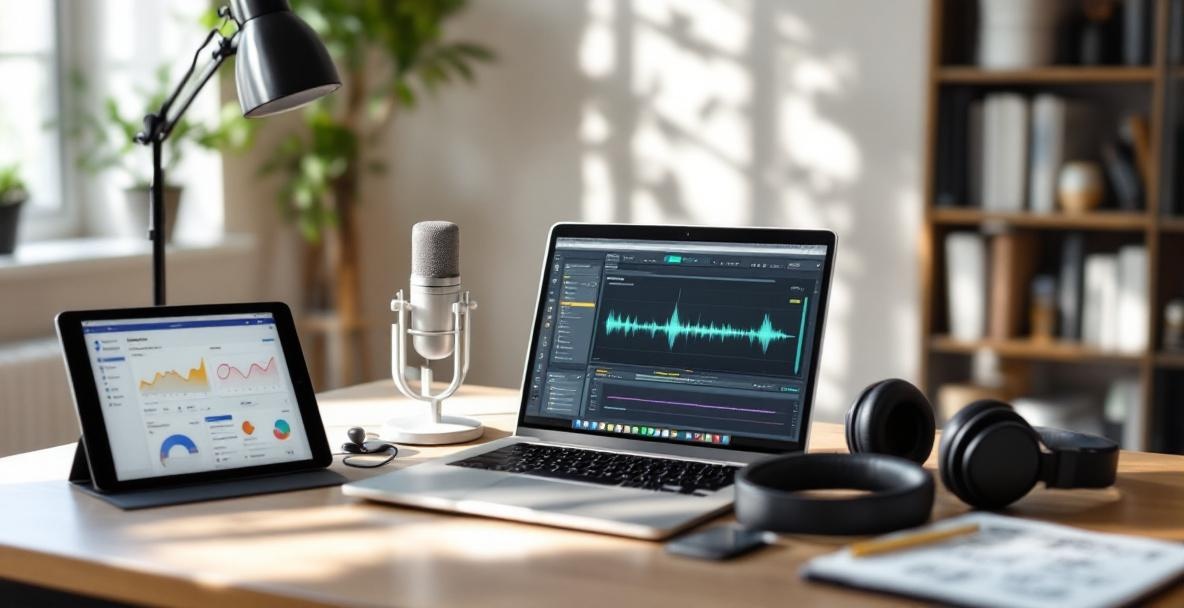You work hard on each podcast episode, and it feels great when you nail the recording. But turning that effort into a wider audience takes more than just a brilliant audio track. At Castee, we have seen that podcasters who mix up their audio into different formats connect with more people. The secret is to transform your content so it shows up wherever your listeners like to hang out.
Why Change Up Your Podcast Content?

Uncovering the Hidden Value
Repurposing your podcast means taking the core of your audio and shaping it for other formats. Think of each episode as the heart of a wider content network rather than a single-purpose file. When you repurpose your podcast effectively, every minute of your recording can work overtime to pull in new listeners.
Reusing your content goes far beyond recycling old material. Each fresh piece you create is a new doorway for someone to discover your show. Someone who might have skipped your podcast on an app can now find a related blog post in search results, see an engaging clip on social media, or stumble across a clear infographic summarizing an important point.
Plus, mixing up your formats respects that everyone has different ways of enjoying content. Some of your fans love to read, while others prefer a quick visual burst instead of long audio. By offering your material in various styles, you make your work more accessible and enjoyable to a broader crowd.
Tackling the Real Struggles
Many podcasters feel the pinch when the time spent on crafting episodes doesn’t equal the results they hoped for. Spending hours on research, recording, and editing is tough when only a small slice of the audience hears it. That effort can seem wasted when your work reaches only a limited number of ears.
Finding the right listeners is another big challenge. With countless shows out there, sticking to traditional podcast directories can leave you unseen. A lot of podcasters also get frustrated because search engines have a hard time picking up spoken words without a clear transcript.
Keeping up with a busy content schedule across different channels can be overwhelming too. Not everyone has the resources to constantly churn out fresh material for every platform. And when all you have are those basic download numbers, it’s hard to see how your ideas are really making an impact.
Knowing Your Listeners and Goals

Figuring Out Who You’re Talking To
Successful repurposing starts with a clear picture of who you want to reach. Look beyond basic stats and think about how your listeners fit their content into their day. Are they busy folks who might skim a quick summary at lunch instead of tuning into a full episode? Or are they people who love scrolling through visual posts on Instagram or TikTok?
Build audience profiles that detail which formats and platforms your fans prefer. If your show is for marketing pros, you might learn they log into LinkedIn during work hours but dive into Instagram when they wind down. This helps you create content that hits the mark for the right crowd.
Pay attention to how people react on your current channels. Notice which topics spark lively debates or questions. These clues can steer you to focus on transforming the parts of your podcast that truly connect with your audience.
Defining Your Own Targets
Before you try any new repurposing idea, it helps to set clear, specific goals. Are you looking to grow your listener base, boost your personal brand, drive business leads, or turn fans into loyal customers? What you want to achieve will shape which repurposing strategies make the most sense.
Set clear, measurable targets for each goal. Instead of just hoping to “get more attention,” decide to aim for outcomes like generating 50 new podcast subscribers each month from a revamped blog post or raising social media engagement by 30% with a few well-placed video clips.
Also, think about how different types of content support various parts of your listener journey. Blog posts can attract new ears through search while a newsletter featuring episode highlights might help keep your most loyal fans coming back for more.
Clever Ways to Give Your Podcast More Life
From Talk to Text
Changing your podcast into written content unlocks great SEO potential and suits those who prefer reading over listening. Begin with a full transcript of your episode, and use that as a springboard for several text pieces.
Long blog posts that expand on your episode ideas can let you add useful links and work keywords into your text naturally. Don’t feel tied to your original episode structure – rearrange the content into a smooth written story that brings forward your best insights.
You can also turn detailed conversations into list-style posts. For example, if you cover several marketing tips, you might create a post titled 7 Proven Podcast Marketing Strategies that breaks down each tip from your chat.
If your show features interviews, a roundup post can work wonders too. Putting together key points from several episodes on a single topic creates a handy guide that shows off different viewpoints. This not only serves value for readers but also motivates your guests to share the content with their audience.
Making Social Channels Pop
Social media is a gold mine for giving your podcast a second life, but each platform needs its own spin. Snip out eye-catching quotes from your episodes to craft text posts on Twitter or LinkedIn. Pick out those golden "aha moments" that stand strong on their own.
Audiograms, which mix sound-wave visuals with text overlays, let you create bite-sized clips that are perfect for sharing. They work best for touching or surprising parts of your show, and keeping them under 60 seconds makes them ideal for Instagram or Facebook.
Adopt a steady visual style that stays true to your podcast’s look. Using recurring designs with consistent colors, fonts, and layouts makes it easier for fans to spot your work amid the noise online.
You might even start a regular series made just for social media. A "Monday Motivation" clip or a "Thursday Throwback" post can become something your followers look forward to week after week.
Bringing in Visuals and Videos
Visuals can grab attention quick, which makes them a smart addition to your repurposing plan. Design infographics that lay out statistics, processes, or frameworks mentioned in your conversations. These visuals work well on platforms like Pinterest and LinkedIn, making complicated ideas easy to digest.
Short videos are another powerful tool on platforms like TikTok, Instagram Reels, and YouTube Shorts. Pick key moments from your podcast and turn them into short videos that capture interest in just a few seconds. Whether you’re talking directly to the camera or showing a simple animation, these clips can make your ideas pop.
For a more detailed approach, you can convert full episodes into YouTube videos. Even if you only use basic images or visual waveforms, YouTube’s search and recommendation features can help your content get noticed.
Slide decks are also an excellent way to share your knowledge, especially if your podcast leans toward business or education. Platforms like SlideShare can drive traffic when you turn your talk into an attractive set of slides that sum up your key points.
Must-Have Tools and Platforms

Streamlining with the Right Tools
Choosing the right tools can make your repurposing work a breeze. For example, transcription services like Descript let you turn speech into text and even edit your audio by tweaking the transcript. This makes it easier to pick out the best parts for repurposing.
Design software like Canva offers ready-made templates for social media graphics, audiograms, and more, so you don’t need to be a pro to create great visuals. Their templates are built to fit the quirks of each social platform, saving you time on adjustments.
Tools like Headliner and Wavve can quickly turn your audio snippets into engaging social videos with animated waveforms, captions, and your own branding. They are built for podcasters who need to create sharable content in a flash.
A steady, organized approach will help you make the most of each episode. This system guides you to figure out which parts of your episode should get extra love when repurposing.
At Castee, we have built an all-in-one platform that ties all these tools together, so you can find the best segments of your podcast and share them widely without extra hassle.
Spreading the Word
Getting your repurposed content out there is just as important as making it. Content management systems like WordPress come with handy plugins for podcasters who regularly turn episodes into blog posts. These plugins help keep your format on point and improve your SEO naturally.
Social media tools let you plan posts in advance, so you stay present online without the daily grind. Platforms like Buffer or Hootsuite let you rework your content for each channel while keeping everything managed in one place.
Email marketing services provide another way to share your content. You can tailor what you send out based on what different parts of your audience like to see and how they interact with your work.
Make sure to take advantage of Castee's distribution features to get your repurposed content to the right crowd at the right time. Their system shows you which channels work best, so you can fine-tune your strategy as you go.
Tracking What Matters

Keeping an Eye on the Numbers
Know what works by setting clear metrics for your repurposing efforts. For example, if growing your listener list is the goal, track how many new subscribers you gain from each piece of repurposed content using unique URLs or promo codes.
Engagement is key, so check how each format performs on social media. Look at likes, comments, shares, and saves to see which repurposed pieces resonate the most with your audience.
For goals aimed at getting more conversions, use tracking methods to follow a user’s journey from the repurposed post to actions like website visits, newsletter sign-ups, or even product purchases.
Recent studies show that brands using a multi-format approach see much higher engagement than those relying on one type of content. This proves the ROI potential of a well-planned repurposing strategy.
Also, keep track of how much time you spend on each format and compare it to the results. This will help you see which content types deliver the best return on investment for your work.
Learning from Your Listeners
Numbers are important, but so is listening to feedback. Read comments and see how your audience reacts to different formats to learn what resonates best.
Surveys can offer extra clues about what your fans enjoy most and how they typically find your content. Ask your community directly which formats they prefer.
Try out small tests by changing headlines, visuals, or video styles to see what gets the best reaction. This trial-and-error approach helps you find a formula that works best for your unique audience.
Podcasters who pay attention to feedback often discover a few standout formats that continuously drive engagement. This lets you focus your energy on what truly matters and make more of an impact.
With the detailed insights from Castee's analytics features, you can bring all this feedback together to build a clearer picture of your repurposing success.
Time to Get Creative!
Wrapping It All Up
Repurposing your podcast isn’t just about stretching the life of an episode – it’s a way to open new doors for your show. When you turn your podcast into different touchpoints, you meet your audience wherever they are. The best podcasters view every episode as a treasure chest filled with ideas waiting to be reshaped and shared in new ways. This thoughtful transformation not only reaches more people but also makes every minute of your hard work count more.
Ready to transform your podcast content into a powerful multi-platform presence?
Visit Castee today to discover how our end-to-end podcast marketing solution can streamline your repurposing workflow, boost your visibility, and help you build meaningful connections with listeners across every digital touchpoint. Let us show you how the right tools and strategy can turn a single podcast episode into dozens of opportunities to grow your audience and maximize your ROI.
Leave a Reply